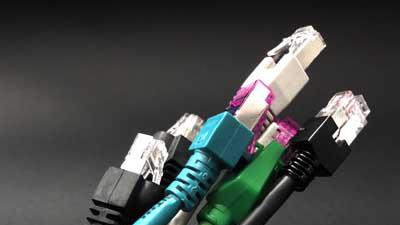Nyansa VP Callisch On The Big Data Boon For Partners And The Looming Battle With Cisco, HPE Aruba
The network analytics startup's software takes in every bit of wireless data, customer information, application data and transactions across the network to figure out where things are going wrong, Vice President of Marketing David Callisch tells CRN.

Small Company, Big Data
For now, network analytics startup Nyansa partners with Cisco Systems and HPE Aruba, but the day is coming when those industry giants will become competitors and the Palo Alto, Calif.,company is girding itself for battle.
David Callisch, Nyansa's vice president of marketing, said the company's advantage lies in its ability to make sense of any network while Cisco and HPE Aruba's network analytics solutions are likely to be custom-tailored to their own environments.
Founded by MIT Ph.D.s, Nyansa offers a network-analytics as-a-service. Its software takes in every bit of wireless data, customer information, application data and transactions across the network to figure out where things are going wrong.
With that information, the Nyansa system tells customers and partners – in plain English – how to fix those problems.
The company works both directly with customers and through the channel, and is looking to double its partner ranks over the next year and a half or so, Callisch said.
What follows is an edited excerpt of Callisch's conversation with CRN.

What's your plan for when Cisco or HPE Aruba come out with something like this?
They're both working on it. Aruba has a product called Insight. Cisco's got a framework called DNA that they're rolling out, but it will take them a super, super long time. We're vendor-agnostic, so we don't tie the customer into any particular vendor. Customers like that, and they like the idea of getting an analytics solution or an infrastructure management solution that allows them to remediate client problems and understand them without being tied into a particular infrastructure. Right now, we're more partners with Cisco and Aruba than we are competitors, but they are starting to push. Everybody and their mother is talking about analytics, but they typically talk about analytics from their particular perspective. Aruba sells it as part of their solution and Cisco will sell it as part of their solution, but we're looking at the entire stack. That's where we're differentiated.

Nyansa will compete with Cisco and HPE Aruba eventually. What advantage do you have in the market?
Wi-Fi is dependent on the wired network to operate properly. Just because the Wi-Fi network and the wired network are working properly doesn't mean the customer can get to an application properly. There could be an application problem. A Cisco or an Aruba would tell you, 'Well, that's somebody else's problem, you have to go get an application performance monitoring solution and use that.' Well, we do all that. We will compete with them, but neither one of them has a mature product that's commercially available, either one of them. We have a little bit of a head start. We've had the fortune to do business with companies that are so large because there's just no solution that will do this from a big data perspective.

What can solution providers expect from a relationship with Nyansa?
A bunch of channel partners have a high level of interest in getting a different kind of product to sell into their customer base. A lot of channel partners don't have an annuity kind of business. A lot of them sell boxes into a customer and walk away or get services, or get ancillary services they charge for where they make a lot of their margin. What interests them about a SaaS service is you have recurring revenue, and our product is vendor-agnostic. We don't care if you have Cisco or Aruba or whoever. We look at the network and figure out for every client that gets on the network exactly what's going on in terms of every transaction the client is having up and down the stack. That client could be a laptop, it could be an IoT device, it could be a phone, it could be anything.

Does it matter if the customer's environment is a mix between traditional gear, software-defined networking or SD-WAN?
It doesn't. We're effectively just staring at all the packets that go over the wire. Our software sits in the network. It just sits off a port, off a switch and we're looking at all the traffic that's traversing the network, both wired and wireless. All it does is communicate with the wireless LAN controller and gets wireless stats. It communicates with the wired network to see all the services that are running over the wired network and then it communicates with the application. It's seeing every client transaction despite what that transaction is, whether it's a WAN transaction, a local-area network transaction, an application transaction. We're analyzing, measuring and correlating all of that across the entire stack.

Does that make it easier for customers' IT people to make sense of their networks?
In large organizations like Home Depot or Procter & Gamble, they have a guy that does wireless, a guy that does servers, a guy that does WAN, a guy that does desktops, and they all use different types of information to figure out their particular discipline. We go across that. We become kind of a single source of truth for all the network guys because we're looking at actual, real-time client data.

What kind of growth have you been seeing in the channel since you launched the product?
When we first came to market, our major focus was higher education. Since that time, we've kind of exploded. We're selling to folks like Tesla and Uber and Nvidia. Any large organization that just doesn't have visibility into the user experience, which is a lot of them. We've managed to scale the channel quite nicely. We started out with a few partners that were midmarket partners. The partners we go after are typically regional guys. It's definitely a value-add for them. It gives them something else to sell, and it helps them sell the rest of their portfolio and become a trusted partner, which is really where the channel wants to be. They don't want to be just a one-and-done kind of partner.

How many partners do you have selling Nyansa now, how many do you want to have, and what type of partner are you looking for?
We continue to add partners every week. We're a small company. We have about 20 partners now. Our revenues are under $10 million, so we're truly a startup and we're trying to redefine the infrastructure management space using big data analytics, machine learning and AI to do that. So, we're at 20 now, and we'll probably double that in the next 18 to 20 months. It's not a mom-and-pop kind of partner we're looking for, it's someone who truly sells up and down the stack. We're really particular about the kind of partner we go after. They have to have a broad understanding of the network, of the access network, not just from a W-iFi perspective. Wi-Fi tends to be the big pain point where a lot of customers don't have a lot of visibility into why things don't operate properly. We'll get involved with a customer through Wi-Fi a lot because the Wi-Fi tools that Cisco and HPE Aruba sell just don't give them the visibility up and down the stack.

What's the impact for partners' revenue as they make the transition to a subscription-based model with Nyansa?
They like it, but they like it for a different reason. They don't like it because they make a ton of money on Nyansa. They do make recurring revenue, which is what they like. They like having a product that gives them a subscription model and an annuity-based business. Moreover, they like it because it allows them to understand how their customers' networks are behaving from a user's perspective. It makes them look smarter. They can go in and sell other products and services, or even professional services to help them fix the networks their clients are running. A lot of customers they sell to will give the partner access to the interface so the partner can actually see how the network is behaving. That's something they haven't been able to do before.

What do you need from partners and prospective partners that they're not necessarily used to doing?
A pretty good understanding of the tools that exist. Customers like GM or Tesla use a whole hodgepodge of different, various software products that do something, but they don't do everything. The partner really needs to understand how the infrastructure management market is changing and the importance the customer is placing on the user experience on the network. The extent to which users can be productive on the network is the extent to which the network is actually working properly. That's kind of a new frame of reference for partners. Partners we look at need to have a good understanding of the campus access network and have a pretty good network of customers that are larger. This is a big data Saas business, the more data we look at, the more valuable we are to that customer. It's not really a solution for a location with five access points. It's a solution for a hospital that has 2,000 access points and 10,000 users that's running bedside monitors and Ascom phones and they don't have any way to manage the experience of that Ascom phone with their clinicians.

Why is the Nyansa system a good fit for the channel?
The reason the channel likes it is because it allows them to become a true partner. A lot of partners sell servers, switches, routers, Wi-Fi access gear. If the customer they're selling to has a problem in an area, say, server capacity or an application platform, that can be quickly identified and the reseller can go sell hardware to that customer. They have a broader view of the network beyond just selling a point product. The solution is a licensed subscription service. Every year the customer renews, they get a piece of the pie. That gives them a subscription-based model they haven't had up until now. That's why the channel likes it. It's a different type of infrastructure solution that customers haven't had. It solves an acute problem for a broad range of people in a given enterprise, whether it's a school or a manufacturing company or a hospital. It transcends vertical markets.

What are you doing with the data you collect? How is it made available to customers?
We're sending the results up to the cloud, and that's where we present that information to the client. All they do is plug in this piece of software and it starts to ingest data. We're able to look at root causes of issues that happen. We're able to look at capacity problems that happen, whether it's with a server, or Wi-Fi or application response. We track a metric called client hours. We look to see how much time clients have lost in terms of connectivity. If we see a certain amount of client hours across a certain dimension, we'll say 'Hey, we're seeing 300,000 lost client hours of connectivity to Office365. If you want to go fix it, here's how you go fix it.'

Is there a configuration element to the system?
We're not configuration management. You don't push a button on our system and auto-magically reconfigure the network to fix that problem. Every vendor that sells hardware products sells some type of configuration management. Cisco does, Aruba does. Customers use that to configure a particular part of the network they have problems with. They have issues finding out where systemic issues lie and what the root cause of it is and how to go fix them. We solve all of that for them.

Can you tell me about a customer and how they're using Nyansa?
Tesla is a customer of ours, and on their production line, they run these robots, these IoT robots. They're basically torque wrenches the line guys use to tighten bolts and do different production procedures. Those things communicate with their back-end product system over Wi-Fi and they use a particular protocol, so there's no way for the network guys to understand if that particular torque wrench or that particular IoT robot is staying sticky with an access point. Is it up? Is it down? Is it operating to the right capacity? If that goes down, production fails. It stops. It's becoming more and more critical. The IT guys in that environment don't have the wherewithal to go and get data from every different part of the network. Is it the production application that's not responding properly? Is it the Wi-Fi devices? It could be a myriad of problems. This solves that problem and gets to the heart of the issue really, really quickly.

What does Nyansa help customers do that they couldn't do before?
We understand how the customer is experiencing the network from a performance management perspective. One of the problems enterprises have is as access networks get more complex – more mobility, more smart devices and IoT devices all with different behaviors on the network – it's increasingly difficult for network engineers and network managers to understand how to pinpoint and find individual client or systemic client problems up and down the stack. They have to go to so many different data sources on the network and they just aren't data scientists. They have to get logs from servers. They have to get information from wireless controllers, they have to get client information, they have to get application information. They basically have to stare at all this information and correlate it themselves. We automate all that process.

How does Nyansa help large customers gain a better understanding of what's going on in their networks?
At the end of the day, what matters most to the enterprise is the productivity of the client on the network. A lot of clients will just say, 'Hey, I have a network problem,' or 'My Wi-Fi stinks.' Well, it might not be the Wi-Fi. It might be an application response-time problem. We're able to quickly identify that in real time for any client that gets on the network, and we're talking about tens of thousands of clients on a large network. This is a big data problem. Instead of the users having to go to all these different sources, we ingest that all and we surface what we see and we translate that into English: In this building on Wednesday you had an Office365 problem with this many clients. Here are the clients. Here's the problem they had. Here's how much connectivity they were unable to get. Here's how you go fix it. We're trying to help predict capacity problems and user performance issues before they happen so they can go fix them.